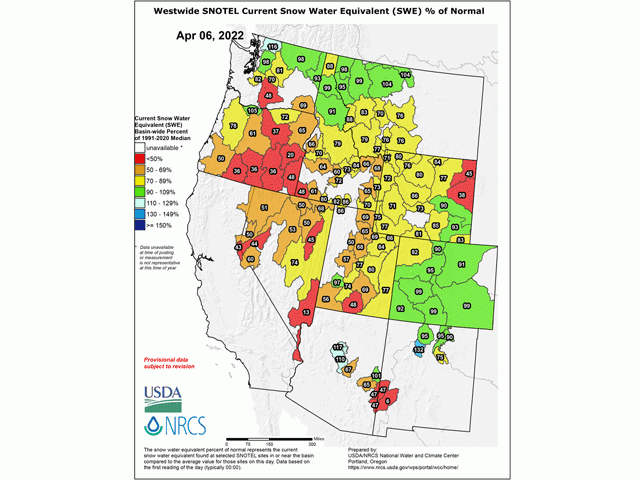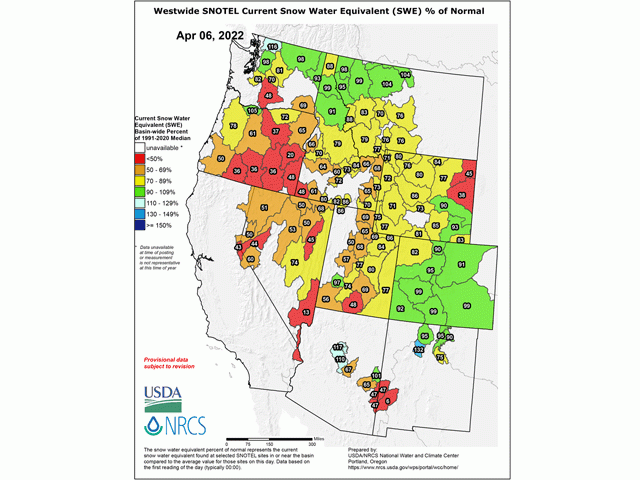Ag Weather Forum
Limited Snowpack Moisture for Dry Western US
Agriculture in the western U.S. faces continued drought as the 2022 spring unfolds. The April 7 U.S. Drought Monitor summary noted worsening drought conditions in some locales dating back to last year, with extremely dry soils, a lack of surface water and poor pasture forage conditions.
"Central Washington, Idaho, and northwest Montana also saw increases in drought extent or severity as short-term dryness continues to build upon long-term moisture deficits extending back to last year," the report emphasized. "Many parts of southern Idaho, and the rest of the West, have set records for the driest three-month period (January to March) going back 100 years or more."
Typically, western U.S. agriculture gets a moisture boost from irrigation supplied by melting snow in the Rocky Mountains, Wasatch Mountains and other regional mountain ranges. However, USDA and NOAA scientists speaking on a snowpack moisture outlook webinar offered a pessimistic forecast for snow water supplies this year.
P[L1] D[0x0] M[300x250] OOP[F] ADUNIT[] T[]
"Snowpack is generally below normal," said Western Region NOAA climatologist Dave Simeral. "Colorado has had some rebound recently. We've also seen some recovery in New Mexico. But a lot of the Southwest has below-average snowpack."
Simeral cited a "pretty typical" La Nina pattern for the overall below-average western U.S. snowpack during the January-to-March time frame. "Basically, what you get during La Nina is high pressure over parts of the western U.S. and storm tracks get diverted northward."
Detailing the downtrend in snowpack soil moisture, Jordan Clayton, USDA Natural Resource Conservation Service (NRCS) snow survey supervisor, focused on very low supplies ahead in the already-dry Colorado River Basin. In the Colorado Basin, "January 11 to March 1 saw the lowest precipitation on record in that 50-day window," Clayton said. And for snowpack moisture, the Upper Colorado's "most likely outcome is the range of the 10th to 30th percentile" for late season snow. In the Lower Colorado, Clayton expects snow water equivalent moisture in the 15th percentile or below for the rest of the season.
The region has been so dry that the river flow levels are forecast to be well-below normal. "Most (river flow) forecasts were in the 60 to 70% of normal range," said NOAA hydrologist Paul Miller of the Colorado River Basin Forecast Center. Miller specifically noted a very low flow into Lake Powell of no more than 64% of average. "There's a chance to get to near normal, but we don't think that chance is very high," Miller said.
Western U.S. agriculture is already taking a hit from this drier trend. Drier ground and lower pasture supplies are already forcing the selling of livestock earlier than normal. In addition, growers are indicating forced management strategy to deal with decreased irrigation water allocation for the 2022 growing season. That will affect crop production on several million acres; the Colorado Basin alone supplies irrigation water for over 3 million acres.
Seasonal forecasts offer no relief for the region. Public and private outlooks call for drought to either maintain or develop during the balance of the spring and into early summer.
Bryce Anderson can be reached at Bryce.anderson@dtn.com
Follow him on Twitter @BAndersonDTN
(c) Copyright 2022 DTN, LLC. All rights reserved.






Comments
To comment, please Log In or Join our Community .